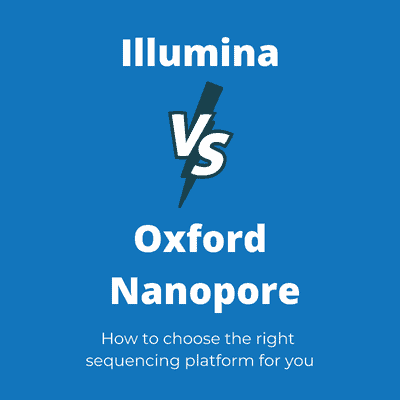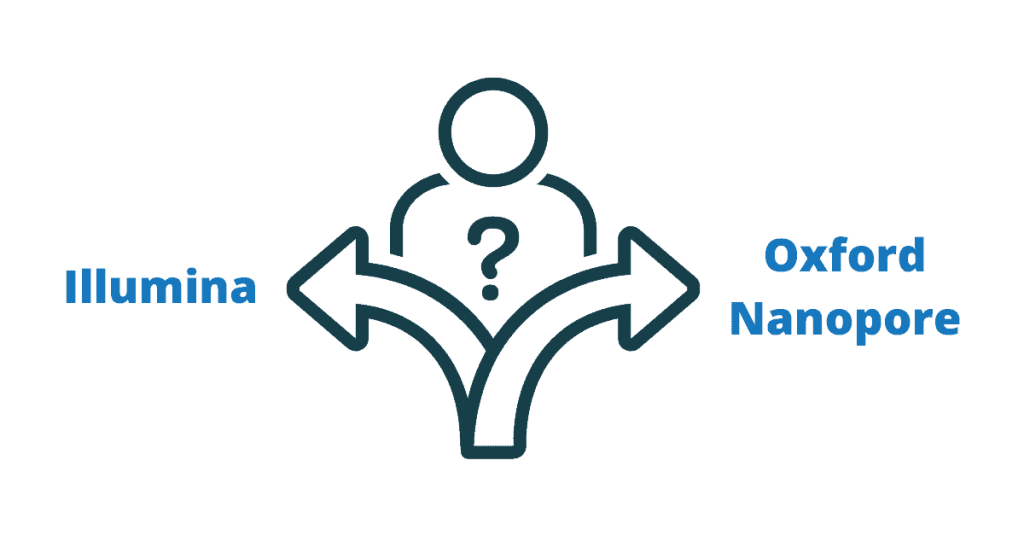NGS Platforms: Illumina vs Oxford Nanopore
- 6th December 2022
- Posted by: Breige McBride
- Category: Sequencing

Illumina vs Oxford Nanopore – who should win the fight to become your lab’s new sequencing provider?
To help you answer this question, you can read overviews of each company and the sequencing technologies they are known for, below. You will also find an overview of the main factors that could drive your purchasing decision such as accuracy, cost, and research application.
These factors are not as simple as they may seem. Take cost as an example. It is not enough to compare prices of an Illumina sequencer and an Oxford Nanopore sequencer. It is also necessary to consider things like the cost per Gb of data generated. For instance, the estimated cost per Gb for the Illumina NovaSeq 5500 is $50-$63. Meanwhile for the Oxford Nanopore PromethION the cost estimate is between $21-$425. Factors contributing to overall instrument costs are discussed later in this article.
Illumina
Founded in 1998 in San Diego, California, Illumina is the dominant player in the gene sequencing market with a market share of around 80%1. Their current product offering includes five benchtop sequencers and 3 production-scale sequencers. The company also provides array scanners. Illumina’s latest sequencing product innovation, NovaSeqX, aims to reduce the cost of sequencing a genome to just $200.
As competition heats up in the sequencing market with the rise of competitors like Oxford Nanopore, Illumina is increasingly branching out into the realm of drug research, recently announcing deals with Nashville Biosciences and Janssen. They have also entered a partnership with a biotech investor, Deerfield Management, to launch new biotechs.
Oxford Nanopore
Founded in 2005 as a spin-out from Oxford University, Oxford Nanopore Technologies has quickly made a name for itself in the next-generation sequencing market. The Oxford-based company whose mission is to ‘enable the analysis of anything by anyone, anywhere’, currently offers 5 sequencing product lines. Their newest product is the PromethION 2 Solo, designed to offer low-cost DNA and RNA sequencing to every laboratory.
At the end of October, Oxford Nanopore Technologies joined the 10x Genomics Compatible Partner Program ‘to enable a streamlined workflow for sequencing full-length transcripts in single reads on highly accessible Oxford Nanopore devices.’
 Illumina Vs Oxford Nanopore – NGS Technology Comparison
Illumina Vs Oxford Nanopore – NGS Technology Comparison
Illumina gained its reputation for its second-generation sequencing technology which uses clonal array formation with reversible terminator technology for large-scale sequencing. Using cluster generation, sequencing template molecules on an Illumina flow cell present DNA in a way that allows access to enzymes. Following this, solid-phase amplification creates up to 1000 copies of the template molecules on the flow cell surface, generating a cluster. A single flow cell can contain 10 million single-molecule clusters per square centimetre.
These tens of millions of clusters are then sequenced using sequencing by synthesis technology (SBS). SBS uses four nucleotides which are fluorescently labelled to sequence the clusters. Learn more about Illumina’s cluster generation and SBS technologies.
Oxford Nanopore, on the other hand, uses a newer sequencing technology that inspired its company name – nanopore sequencing. A nanopore is a tiny hole (a nanometer in size) formed by the structural conformation of a protein. Oxford Nanopore uses flow cells in their sequencers which contain an array of nanopores in an electro-resistant membrane. Each DNA or RNA molecule that passes through one of the nanopores disrupts the current in a different way, enabling the identification of the molecule and its DNA or RNA sequence. Learn more about Oxford Nanopore’s nanopore sequencing technology.
It is important to note that Oxford Nanopore is not the only sequencing provider using nanopore technology. In fact, Illumina is also developing nanopore technology2.
Sequencing Read Length – Illumina Vs Oxford Nanopore
NGS read length indicates the number of base pairs sequenced from a fragment of DNA. In NGS, the overlapping regions between reads are what are used to reconstruct the full DNA sequence, by assembling and aligning the reads to a reference genome.
Short and long read lengths are best for different applications. Short-read lengths are best for applications like small RNA sequencing and gene expression profiling. On the other hand, long-read lengths are best for de novo assembly because they allow for more sequence overlap.
Illumina and Oxford Nanopore tend to be associated with different read lengths. Although Illumina’s product offering has different sequencers for short-read and long-read sequencing, it is best known for short-read sequencing products. By contrast, Oxford Nanopore is best known for long-read sequencing. In fact, nanopore sequencing provides the longest read lengths of all NGS technologies3.
 How to Choose Between Illumina and Oxford Nanopore Sequencers
How to Choose Between Illumina and Oxford Nanopore Sequencers
The first thing to consider when choosing a sequencing platform is what you will use it for. You should consider your sequencing applications and whether short or long-read sequencing will suit them best. If you are unsure which read length will be best for your application this application read length table from Illumina may help you decide.
You should also factor in which read accuracy will be most suitable for your intended NGS applications, as different NGS technologies and sequencers have different read accuracy percentages. Illumina sequencers tend to be high accuracy with a read accuracy of >99.9% while Oxford Nanopore provides sequencers with a read accuracy of between 87% and 98%4.
Of course, the cost usually plays an important role in any purchasing decision. As we mention at the beginning of this article, when comparing the costs of sequencing it is not enough to simply compare the instrument costs (which can vary greatly). You should also take into consideration the cost per sample and the cost per gigabase (Gb) of data generated. For example, the estimated cost per Gb for the Illumina NovaSeq 5500 is $50-$63, while for the Oxford Nanopore PromethION the cost estimate is between $21-$425. It is also prudent to factor the sequencing instrument’s maintenance requirements and costs into your decision.
NGS Data Analysis
No matter which sequencer provider you choose, you will need to analyse the NGS data your sequencer generates. Fios Genomics analyse NGS data from Illumina and Oxford Nanopore sequencers, as well as from all other sequencer providers. Learn more about our NGS data analysis expertise or contact us now to discuss your analysis needs.
Want our support?
Just tell us what you need using the form below, and one of our bioinformatics specialists will be in touch to discuss how we can support your research!
Sources
1 https://www.biospace.com/article/top-10-gene-sequencing-companies-by-revenue/
2 https://www.sharesmagazine.co.uk/article/oxford-nanopore-takes-aim-at-market-leader-illumina
4, 5 https://www.ncbi.nlm.nih.gov/pmc/articles/PMC8301755/table/biosensors-11-00214-t001/
Author: Breige McBride, Content and Social Media Manager, Fios Genomics
Reviewed by Fios Genomics Bioinformatics Experts to ensure accuracy
See Also
Gene Expression Analysis from Fios Genomics
Bioinformatics Buyer’s Guide – Outsourcing Handbook
How Bioinformatics Can Support Your Clinical Trial
Biological Data Mining and Landscaping Whitepaper
Leave a Reply
You must be logged in to post a comment.

